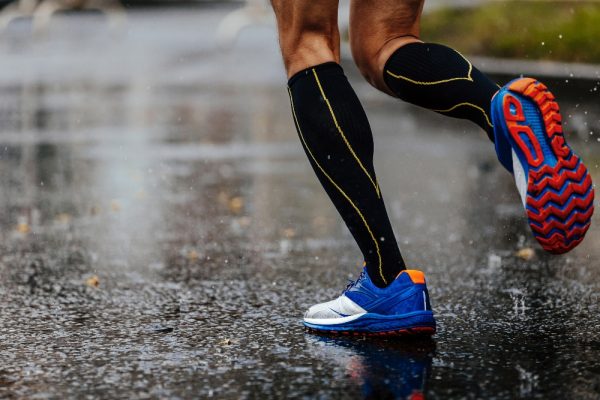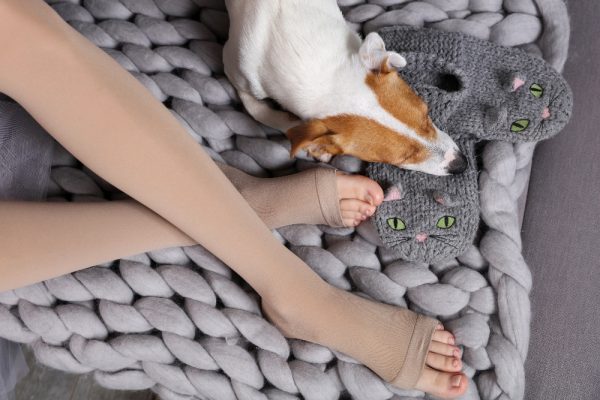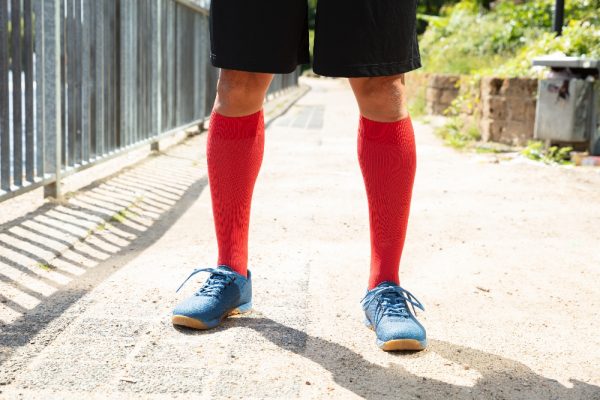Many people of varying ages ask our podiatrists about the benefits of compression socks: should they be wearing them while running? What about while sitting for hours working at their desk? On a flight?
The short answer is… yes! Everyone can benefit from wearing pressured socks during certain periods, which we’ll expand upon in this post.
We’ve compiled a few facts about compression socks to help you understand when to slip them on, and how to find the right pair for you.

The Benefits of Compression Socks
Perhaps the number one way compression socks benefit you is by stimulating blood flow upward. The added pressure of these form-fitting socks around your feet, ankles and legs encourages blood in the veins of your legs to travel to your heart— reducing the likelihood of a blockage.
In simplest terms, compression socks help to reduce your chances of developing a blood clot. The extra pressure promotes better circulation both for those always on the feet and those frequently off of them.
When to Wear Compression Socks
Ironically, both those who are inactive and those who are very active can benefit from wearing compression socks. Let’s see why these polar opposite types need a little extra pressure.
- On a long flight. If you’re stuck in a confined space and unable to walk for many hours, compression socks can help to reduce your risk of developing a blood clot. They’re becoming a more and more popular staple for flights. Even celebrities like Jessica Alba attest to wearing them while traveling.
- If you’re on bed rest following surgery. If you broke a bone in your foot or recently had surgery that prevents you from moving, compression socks can help to reduce dangerous stagnation within your blood. Elderly patients often benefit from pressured socks or stockings in particular, but really anyone whose movement is limited can benefit from wearing a pair.

- If you have swollen feet or legs. There are a number of reasons that you could experience swelling in your feet or legs, so be sure to seek a professional opinion before diagnosing the cause. However, those with poor return of fluid from their leg veins with conditions like Deep Venous Thrombosis (DVT) or Pulmonary Embolism (PE) or other venous disorders can often benefit from compression socks or stockings.
- If you have varicose veins. Those with varicose veins have blood collect in the small valves behind the veins instead of flowing to their heart. Protruding varicose veins can be quite painful, and compression socks can help to stop the veins from growing worse and encourage better upward movement.
- If you’re active for long bouts of time. Those on their feet for hours upon hours at a time are great candidates for compression socks. Why? Marathon runners, waiting staff, pharmacists and those who stand or move for extended periods of time can overburden their veins and muscles. Pressured stockings or socks can increase circulation and provide relief for tired muscles.
- If you have a foot condition. We have patients with previous conditions like Plantar Fasciitis that find relief wearing compression socks with padded heels, arch or toe support. Those suffering from foot or ankle conditions may need different socks than we detail in this article, for honing in on problematic areas.
How Long to Wear Your Pressure Socks
There’s really no need to monitor how long you wear compression socks for in the span of a day. You can wear them for a few hours, or for most of the day— just be sure to take them off before bed.* Unless advised to wear them overnight by a doctor.

Choosing the Right Pressure
Generally, there are three different levels of compression ratings: mild, medium and high. They are measured in mmHg, which categorizes the amount of pressure or firmness around your legs, ankles and feet.
- Less than 15 mmHg. This mild pressure is perfect for those on their feet for long periods a day. It’s enough support to combat muscle fatigue and swelling from extended vertical positioning.
- 15 to 20 mmHg. This is the perfect amount of pressure for those worried about developing a blood clot while flying or for those with minor swelling. It’s the medium compression level and can help to relieve varicose vein pain.
- 20 mmHg to more than 40 mmHg. This a medical grade level, usually recommended by a doctor to help with bad veins, severe swelling problems or those forced on bed rest.
Generally speaking, you want to look for compression socks that are tight but not uncomfortable. Most of our patients looking for extra support while running or while traveling are good with one of the top two options.
Personalized Advice on Choosing Compression Socks
We usually never advise self-diagnosing. While compression socks can be a tremendous aid to many, you should always talk to a professional before picking a style and tightness for your lifestyle.
Our podiatrists can recommend the best compression socks for you and your specific needs. Visit our contact page to make a quick appointment or give us a call today at 239.936.5400.
Categorized in: Blog